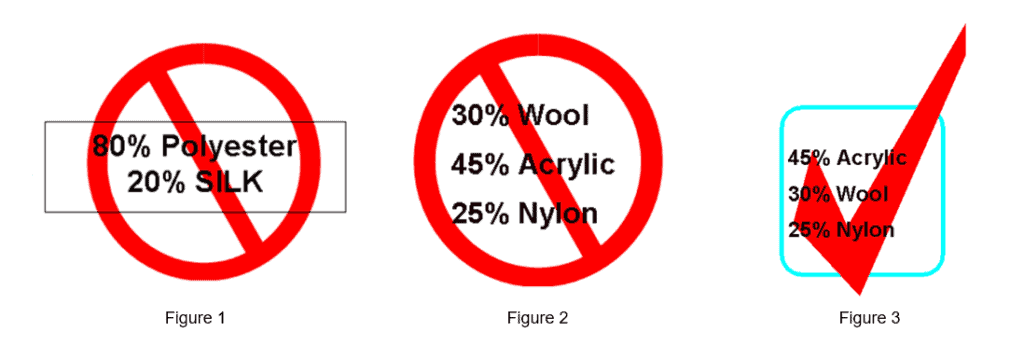The United States Federal Trade Commission (FTC) and Customs Service Regulations require the correct labeling of products. Incomplete or misleading labeling information may result in products being rejected at borders, or costly recalls that inevitably damage a brand’s image. Product labeling has become a serious business nowadays.
With four sessions, this article is designed to help you take out the unnecessary guesswork and to be clear about the US fiber content requirements for apparel products.
1. Textile Fiber Products Identification Act: 16 CFR 303
The Textile Fiber Products Identification Act was passed “to protect the public against misbranding and false advertising” of textile articles. By law, the following information, in English, is required on textile products covered by the Act. The Act is under the jurisdiction of the Federal Trade Commission (FTC). For the entire Act see 16 CFR Part 303.
- Covered products – apply all the rules that are set forth in the regulation:
- Clothing, curtains, throws, towels, scarves, socks, bedding, umbrellas etc.
2. Exempt products – Apply only the truth in labeling criteria. Information given must be truthful since the regulation does not cover these items, therefore none of the rules would apply:
- Over Mitts, Bags, Linings, Wall coverings, Tea Cozies, Mops, Backings, Saddle Blankets, Shoes, Headwear etc.
3. Not covered unless something about the fiber
- If there is fiber disclosure then apply all the rules that are set forth in the regulation
- If there is no fiber disclosure then the rules do not apply
2. Mechanics of Labeling
All fiber label must be present at the point of sale and disclose in English. They can also be displayed with other language, as long as the English version is included. The label should also clearly legible, conspicuous and readily accessible to the consumer. All parts of the label must be same type and size of lettering and be conspicuous like figure 1.
The generic fiber names and percentage of each fiber must be listed in descending order of predominance by weight (see figure 2). If the goods are sold in packaging and the fiber label is not visible through the packaging, the fiber label content must be printed on the packaging.

Fibers which contain less than 5% of the total fiber weight MUST be disclosed as “other fiber (s)”. For fiber names with functional significance, consisting of less than 5% of the total fiber weight of the product, may be listed without indicating the functional significance of the fibers. For instance: 96% Cotton, 4% Spandex.
For fibers that are 5% or more, they MUST disclose the generic fiber name. For wool and recycled wool, these are two types of fiber that MUST be disclosed even less than 5%.
3. Generic Fiber Names
Both natural and man-made fibers must be identified by their generic names. The current fiber content rule allows the use of fiber names described in ISO (International Standards Organization)
Previous Requirement | New Regulation |
Rayon | Viscose or Rayon |
Spandex | Elastane or Spandex |
Nylon | Polyamide or Nylon |
4. Fiber Content Labeling
For cotton, the type of cotton may be included as long as it is not deceptive, for instance: 100% Pima Cotton. A fiber trademark may be used on the content but must be accompanied by the generic fiber name, for instance: Lycra® Spandex. If trademark does not appear in the content disclosure but appears elsewhere on the label, the generic name must be appear together with the trademark which being used at the first time, for instance: 80% cotton, 20% spandex, Lycra® Spandex, Lycra® for fit.
1. Exemptions
Exemption to the fiber disclosure requirement includes:
- Trimmings: Collars, cuffs, braiding, wrist or wrist bands, rickrack, tape, belting, labels, leg bands, gussets, gores, welts and superimposed hosiery garters
- Linings (unless used for warmth)
- Sewing threads
- Findings: Elastic materials and threads used in minor proportions for structured purposes and elastic materials that is part of base fabric if the elastic does not exceed 20% of the surface area, fiber content should be followed by the statement “Exclusive of elastic”
Exemption to the fiber disclosure requirement includes:
For Decorative trims / patterns or design / Ornamentation
- Embroidery or appliqués
- Decorative patterns or designs that are an integral part of the fabric
- Ornamentation: Any fibers or yarns imparting a visibly discernible pattern or design to a yarn or fabric.
- If the above decorative items are made of different fiber from base fabric and more than 15% by surface area, or 5% by the fiber weight, the fiber of the decoration must be disclosed on the label. Otherwise, it is no need to disclose its content if the label says “exclusive of decoration” or “exclusive of ornamentation”.
2. Sectional Disclosure
If the product has separate sections with different fiber compositions, the content of each section must be identified. When ornamentation or decorative trim are non-exempt, its fiber must be disclosed.
- For example:
- Body: 100% Cotton
- Sleeve: 70% Cotton, 30% Polyester
- Red: 100% Polyester
- Blue: 100% Cotton
- Green: 80% Cotton, 20% Polyester
- Ornamentation: 100% Silk
5. Summary
To sum up the above 4 major requirements for fiber content label for apparel manufactured, imported and sold in the US:
- All the apparel must have the fiber label at the point of sale
- Only the generic fiber names can be used
- Must be in descending order by weight
- Must comply with rules and no intent to deceive the consumer.
Recommendations from Bureau Veritas:
Apart from the above, there are other regulatory requirements for fiber content and fur content including country of origin, legal identification, care labeling and more. It is compulsory for your products to comply with the related safety standards when importing them into the US & EU retail markets. Manufacturers and suppliers or any stakeholders within the supply chain may seek help from accredited third-party solution providers, in order to mitigate risks and speed up market access.

Stephen LIM
Director, Business Development of Bureau Veritas Consumer Products Services
Content contributor: Bureau Veritas CPS HK (All rights reserved)
Bureau Veritas is a global consumer and technology product testing, inspection/audit and certification body, offering one-stop-shop solutions to all your global market access needs. If you have any comments and/or questions about this article, please visit: https://www.cps.bureauveritas.com




















